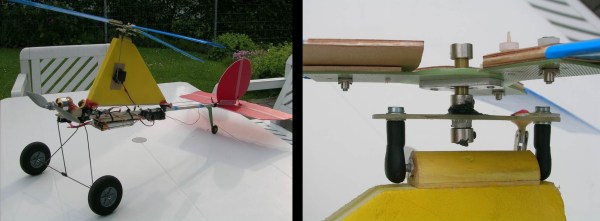Out in the RC Airplane world, there is a great airframe called the Slow Stick. There is not much going on with this plane as it only has the bare necessities, a motor, wing, tail and a fiberglass tube (hence the ‘stick’ part of Slow Stick) as the fuselage. Yes, and as the name suggests it is slow. Although it’s intent is to be a starter plane for beginners, even experienced pilots like it because it is cheap, easy to repair and fun to modify. [StephanB] is the type of guy who likes to modify things so he set out to convert his Slow Stick to an Autogyro.
An Autogyro can be described as a cross between a plane and a helicopter. Like a plane it has a propeller that provides forward thrust. Unlike a plane, it does not have a wing. To provide lift, there is a large helicopter-like rotor on top of the craft but this rotor is not powered. It only spins when the craft is moving forward. Lift is created when the rotor is spinning, allowing the Autogyro to take off.
[StephanB] started by removing his Slow Stick’s wing. This takes all of 2 seconds and consists of only removing 2 rubber bands. Next he built a frame for the rotor. It was made to fit the wing mounts of the Slow Stick so that it could be quickly converted back to a plane. With a spinning Autogyro rotor, the side that the rotor is traveling in the forward direction creates more lift than the side of the rotor traveling rearward. To compensate for this unequal lift, [StephanB] added a sideways tilting rotor mount. An RC servo is connected to the mount and allows remote control of the rotor to balance out the lift.




 The four-lane, 38-foot run was made out of five sections of cabinet plywood attached with 4″ lap joints. That’s the way to do it if you want a smooth running surface. The lanes are 1/4″ strips of maple plywood, and the last four feet of the track – after the finish line, of course – are a ramp that raises the lanes another 1/2″ above the ground. There’s very little need for a bunch of pillows or foam at the end of the track.
The four-lane, 38-foot run was made out of five sections of cabinet plywood attached with 4″ lap joints. That’s the way to do it if you want a smooth running surface. The lanes are 1/4″ strips of maple plywood, and the last four feet of the track – after the finish line, of course – are a ramp that raises the lanes another 1/2″ above the ground. There’s very little need for a bunch of pillows or foam at the end of the track.













